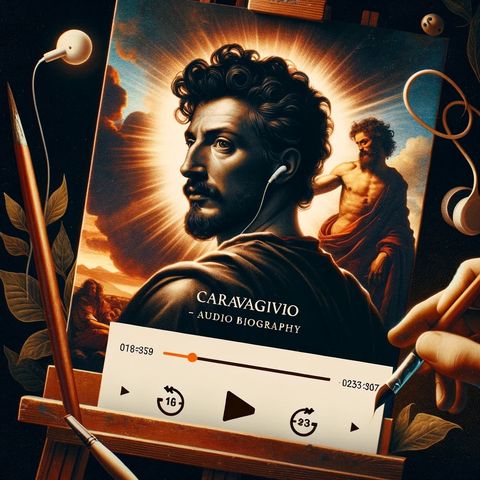Caravaggio Biography

Scarica e ascolta ovunque
Scarica i tuoi episodi preferiti e goditi l'ascolto, ovunque tu sia! Iscriviti o accedi ora per ascoltare offline.
Caravaggio Biography
Questa è una trascrizione generata automaticamente. Si prega di notare che non è garantita la completa accuratezza.
Descrizione
Michelangelo Merisi da Caravaggio was born in 1571 in Milan, Italy. His father, Fermo Merisi, was a mason, architect, and majordomo of the Marchese of Caravaggio. His mother, Lucia Aratori,...
mostra di piùIn 1584 Caravaggio became an apprentice under the well-established painter Simone Peterzano in Milan for four years. Peterzano had studied directly under Titian in Venice, exposing Caravaggio early on to the Venetian style of painting. Caravaggio left Milan after his apprenticeship ended, possibly due to unrest from Spanish rule, and spent some time wandering between Lombardy, Venice, Rome and Tuscany over the next few years. During this period he was able to further his study of painting techniques and styles, working off and on as an assistant or self-taught copyist.
Around 1592 Caravaggio arrived in Rome, a burgeoning center for the arts and a place where he would create his most famous works. He found work as an assistant for Giuseppe Cesari, an already successful Mannerist painter who recognized Caravaggio's talent. During this first Roman period Caravaggio painted many genre paintings depicting Roman daily life, young boys gambling, fortune telling, playing music and fruit-selling, etc. Caravaggio's styles began breaking from his academic training, showing a unique naturalistic realism, dramatic lighting (tenebrism), and backgrounds devoid of embellishments. Caravaggio also painted some religious works during this time.
Caravaggio's reputation grew and in 1599 he caught the influential eye of Cardinal Francesco del Monte, a diplomat, art collector and patron. The Cardinal gave Caravaggio his own apartment to use as a studio and was one of his first major patrons for religious paintings. Caravaggio's career took off and over the next decade he received several important commissions for altarpieces and other paintings from Roman nobility and clergy as well as religious institutions.
Some of Caravaggio's most acclaimed works were created during his years under Cardinal del Monte's patronage from 1599 to 1606. Paintings like The Calling of Saint Matthew (1600), The Crucifixion of Saint Peter (1601), The Conversion of Saint Paul and Amor Victorious (1602-1603), reflect Caravaggio's distinct and innovative style as well as his amazing talent and technical mastery. He was able to imbue his biblical scenes with a remarkably realistic and dramatic quality that had never been done before. His figures were peasants with dirty feet placed directly in the foreground, breaking the classically idealized treatment that had dominated religious art. He worked directly from posed models, seeking to capture detailed human anatomy and emotion through accentuated chiaroscuro. His compositions utilized the dark background to bring lighted subjects prominently forward in stark relief.
Caravaggio's style earned him fame and prestige, but his penchant for street brawls and sword fights also brought trouble from the law. In 1606 Caravaggio killed a man, Ranuccio Tomassoni, in a fight over a tennis score. Deemed a murder, Caravaggio had to flee Rome as an outlaw with a death sentence hanging over him. From this point until his early death at age 38, Caravaggio lived and worked mostly on the run.
Despite being a fugitive for his remaining four years, Caravaggio created many compelling paintings during this period. He fled first to Naples for 9 months under the protection of nobles like Costanza Colonna. Major works from his Neapolitan period include The Seven Works of Mercy (1607), The Flagellation of Christ and The Denial of Saint Peter (1607). His chiaroscuro darkeness increased as seen in dramatic late works like The Martyrdom of Saint Ursula (1610) and The Burial of St. Lucy (1608).
Caravaggio hoped a pardon could be arranged in Rome so he made an arduous journey back in 1609-1610, staying in out of the way spots in the smaller Duchy of Modena and the Papal States. During these final two years Caravaggio painted intensely, sending works to Rome in advance of him. His final paintings like David with the Head of Goliath (showing self-portraiture of the artist) and his most somber Martyrdom of Saint Lawrence (1610) have an almost near-death feel. Upon returning at long last to Rome in 1610, Caravaggio discovered the pardon he desperately sought was still denied. Just days later, at age 38, he died alone on a beach from causes that remain uncertain.
Informazioni
| Autore | QP-3 |
| Organizzazione | William Corbin |
| Sito | - |
| Tag |
Copyright 2024 - Spreaker Inc. an iHeartMedia Company
